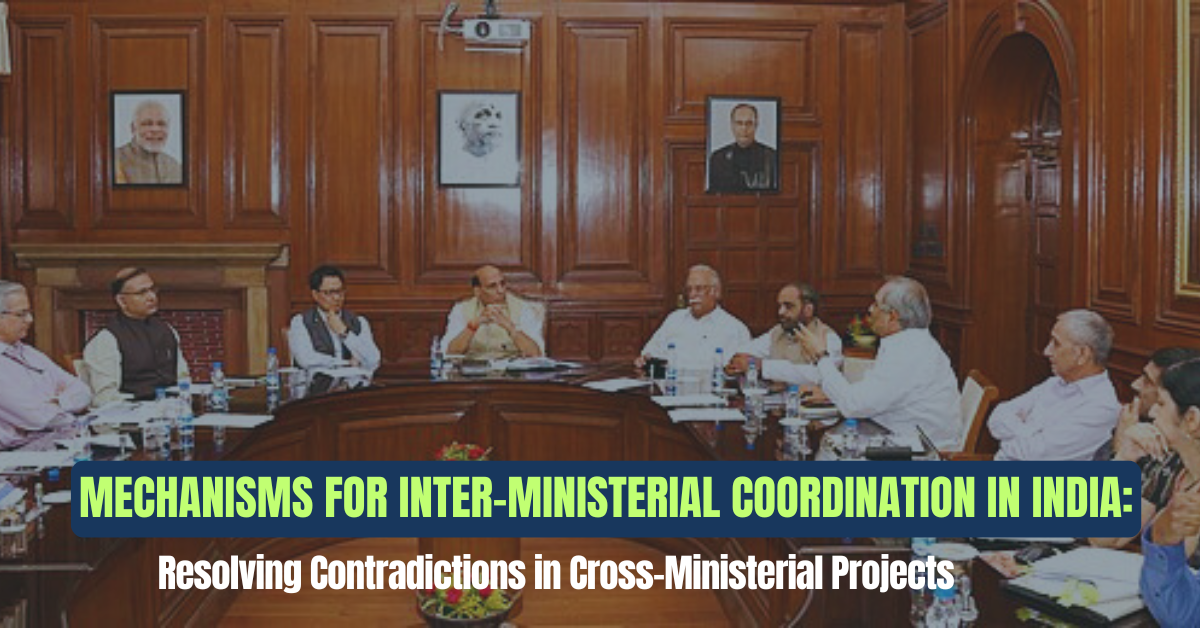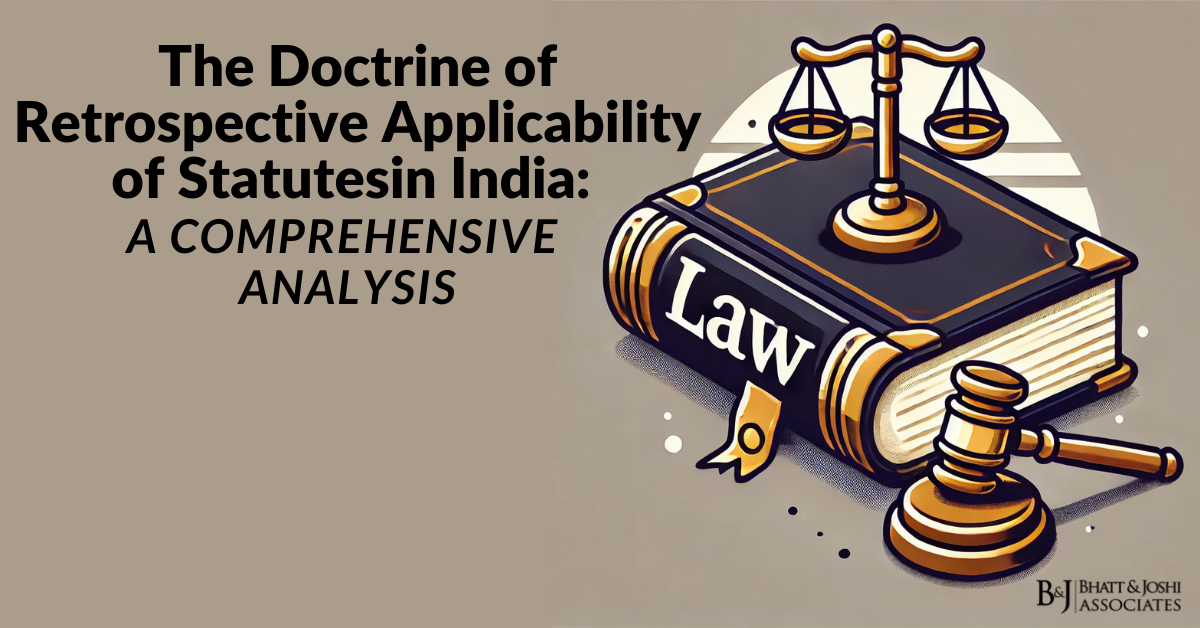Introduction
India’s federal structure and complex governance landscape often necessitate collaboration between multiple ministries to implement large-scale projects. However, overlapping jurisdictions, competing priorities, and resource constraints frequently lead to inter-ministerial contradictions. Over the years, India has developed a multi-layered framework to address such conflicts, blending constitutional mandates, institutional mechanisms, and ad-hoc interventions. This report examines the formal and informal systems that facilitate inter-ministerial coordination in India, evaluates their effectiveness, and identifies persistent challenges.
Institutional Mechanisms for Coordination in India
The Inter-Ministerial Coordination Group (IMCG)
Established in 2022 under the Ministry of External Affairs, the IMCG represents a high-level, secretary-led body designed to mainstream India’s “Neighbourhood First” policy. By bringing together ministries such as Home, Commerce, Finance, and Defence, the IMCG addresses conflicts in cross-border infrastructure, trade, and security through a “whole-of-government” approach. For instance, it resolved disputes over connectivity projects with Nepal by harmonizing the objectives of the Railways and Border Security forces. The IMCG is supported by Joint Task Forces (JTFs) at the joint secretary level, which operationalize decisions through sector-specific working groups.
PRAGATI: Pro-Active Governance and Timely Implementation
Launched in 2015, PRAGATI is a digital platform chaired by the Prime Minister to resolve inter-ministerial bottlenecks. It integrates three technologies—video conferencing, digital data management, and geo-spatial analysis—to review projects in real time. For example, delays in the Mumbai-Ahmedabad bullet train project, stemming from disagreements between the Railways and Environment ministries over land acquisition, were expedited through PRAGATI-led deliberations. The platform has addressed over 300 projects since its inception, emphasizing time-bound resolutions.
PARIVESH and Single-Window Clearances
The PARIVESH (Pro-Active and Responsive facilitation by Interactive, Virtuous, and Environmental Single-window Hub) system, introduced in 2018, streamlines environmental clearances across ministries. By creating a unified portal for submissions from the Environment, Forest, and Wildlife departments, it reduced conflicts in infrastructure projects like highway expansions, where the Transport and Tribal Affairs ministries previously clashed over forest rights.
Structural Interventions and Policy Frameworks
Merging of Ministries
The Modi government’s 2014 decision to merge portfolios with overlapping interests—such as Power, Coal, and Renewable Energy under one minister—sought to preempt conflicts. This structural shift allowed faster resolutions in cases like coal allocation for thermal plants, where earlier disputes between the Power and Coal ministries caused delays. However, critics argue that such mergers risk administrative overload and stifle dissenting voices, as seen in the Steel and Mines ministries’ royalty negotiations, where objections were sidelined due to unified leadership.
NITI Aayog’s Program Management Approach
NITI Aayog’s 2019 Task Force on Project Management advocated for program-based governance to replace siloed project execution. For instance, the Bharatmala Pariyojana (highway development program) involved 16 ministries, with NITI Aayog mediating disputes between the Road Transport and Urban Development ministries over urban corridor designs. The Task Force emphasized “cross-functional integration” through shared digital dashboards and standardized reporting formats.
Challenges in Inter-Ministerial Coordination in India
Bureaucratic Silos and Competing Mandates
The lack of institutionalized communication channels often perpetuates conflicts. A 2024 study noted that 43% of delayed infrastructure projects faced inter-ministerial disagreements over jurisdiction, such as the Ken-Betwa river interlinking project, where the Water Resources and Environment ministries clashed over environmental impact assessments. Overlapping schemes like Smart Cities (Urban Development) and AMRUT (Housing) further strain coordination due to duplicated efforts.
Resource Allocation and Political Prioritization
Competition for funds and political visibility exacerbates conflicts. The Sagarmala (port-led development) and Bharatmala (highway) initiatives, both under the Transport Ministry, faced internal clashes over budget allocations, requiring PMO intervention to rebalance priorities. Similarly, the PRAKASH portal, designed to coordinate coal supply between Railways, Power, and Coal ministries, struggled during peak demand periods due to inflexible allocation algorithms.
Legal and Constitutional Gaps
While the Inter-State Council (Article 263) resolves state-centre disputes, no equivalent constitutional body exists for inter-ministerial conflicts. The National Development Council (NDC), which coordinates economic policies, lacks enforcement power, leading to non-binding recommendations, as seen in the stalled GST rate rationalization between the Finance and Textiles ministries.
Case Studies in Conflict Resolution
Cross-Border Infrastructure with Nepal
The 2022 IMCG meeting resolved a decade-long stalemate over the Raxaul-Kathmandu rail link by aligning the Railways Ministry’s technical plans with the Home Ministry’s border security protocols. Joint Task Forces facilitated land surveys and financing agreements, demonstrating the efficacy of structured dialogue.
Renewable Energy and Grid Management
Conflicts between the Power and New & Renewable Energy ministries over grid stability led to the creation of the Green Energy Corridor project. Managed by NITI Aayog, the project involved real-time data sharing between ministries and state DISCOMs, reducing interstate transmission disputes by 60%.
Recommendations for Strengthening Inter-Ministerial Coordination
Institutionalize the IMCG Model Across Sectors
Expanding the IMCG’s mandate to domestic projects, as proposed by the Punchhi Commission, could provide a template for resolving conflicts in healthcare, education, and digital infrastructure.
Legislate a Conflict Resolution Framework
A statutory body akin to the Inter-State Council, empowered to issue binding decisions, would address jurisdictional ambiguities. The Second Administrative Reforms Commission’s recommendation for a quasi-judicial Inter-Ministerial Council remains critical.
Enhance Digital Integration
Scaling PRAGATI’s success requires integrating AI-driven predictive analytics to flag conflicts during project planning stages. The EU’s “Joined-Up Government” model, which uses blockchain for inter-agency contracts, offers a replicable framework.
Capacity Building
Training civil servants in collaborative governance, as piloted by the MEA’s 2022 “Neighbourhood First” module, can reduce adversarial mindsets. The UNDP’s emphasis on “mutual adjustent” mechanisms—regular informal consultations—complements formal structures.
Conclusion: Advancing Inter-Ministerial Coordination in India
Mechanisms for Inter-Ministerial coordination in India reflect a blend of innovation and inertia. While platforms like PRAGATI and structural reforms such as merged ministries have alleviated some conflicts, systemic challenges persist. The absence of a constitutional mandate for inter-ministerial dispute resolution, coupled with bureaucratic fragmentation, undermines large-scale projects. Moving forward, India must adopt a three-pronged strategy: constitutional empowerment of coordination bodies, nationwide digitization of governance workflows, and cultural shifts toward collaborative federalism. Only then can the vision of a “Whole of Government” approach, articulated in initiatives like the IMCG, be fully realized.














